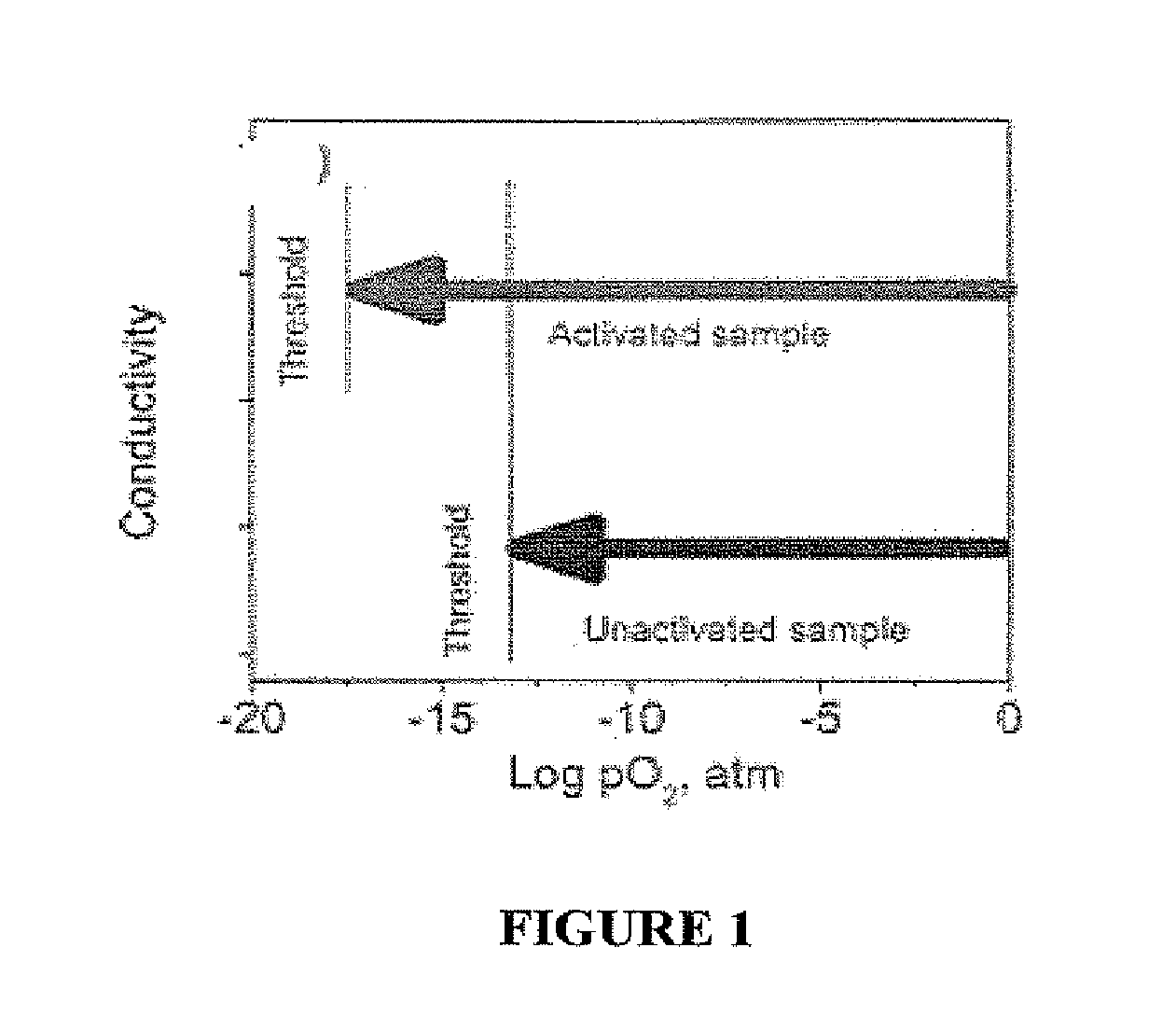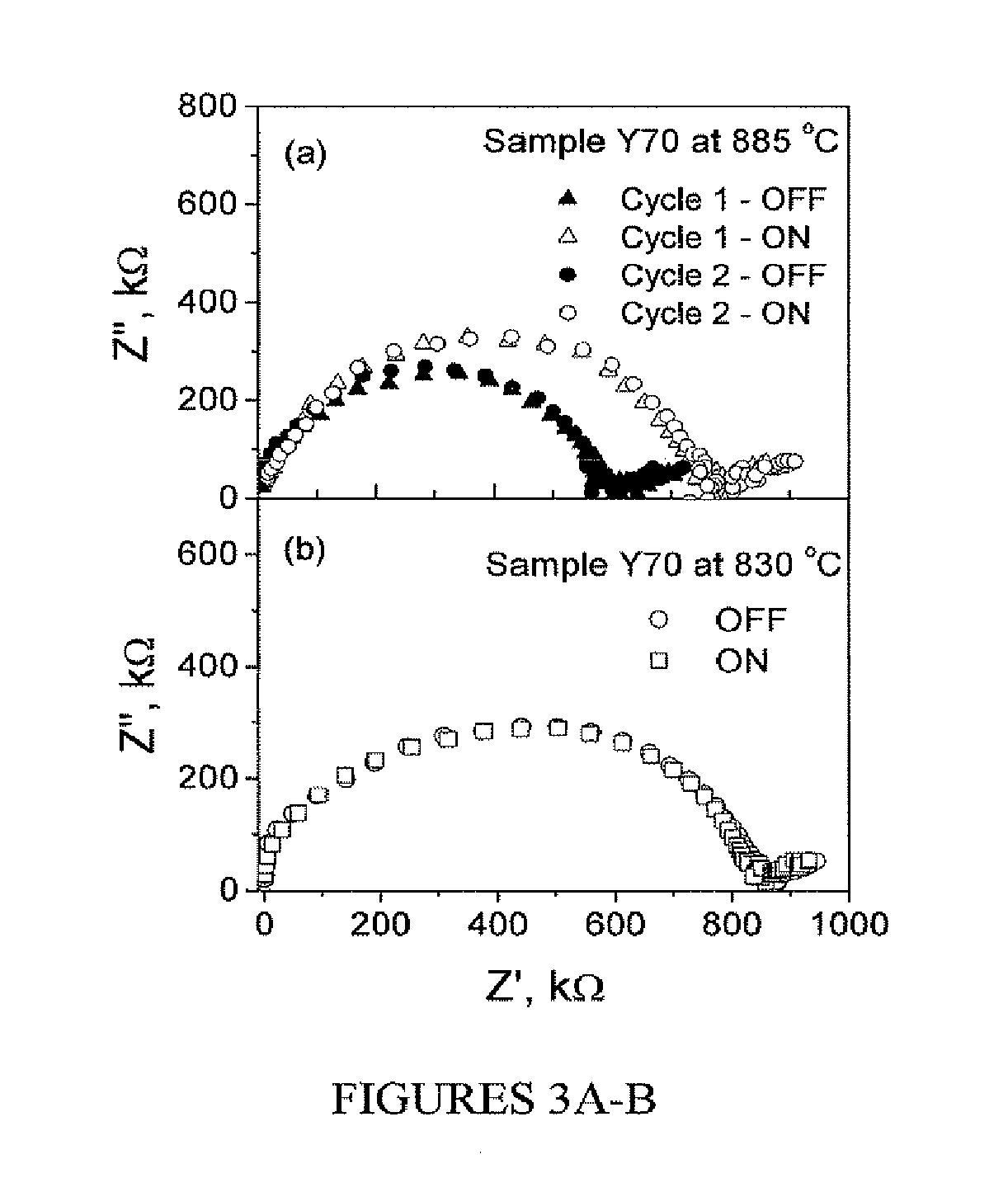Photo-activation of solid oxide fuel cells and gas separation devices
a solid oxide fuel cell and photoactivation technology, applied in the direction of electric/magnetic/electromagnetic heating, final product manufacturing, sustainable manufacturing/processing, etc., can solve the problems of limited commercial application of one or more of the oxide ion conducting portions of many of these devices, and the choice of materials for the electrodes and structural components of the cell (membrane support, gas handling, sealants) is severely constrained, so as to reduce the conductivity of an oxid
- Summary
- Abstract
- Description
- Claims
- Application Information
AI Technical Summary
Benefits of technology
Problems solved by technology
Method used
Image
Examples
example 1
Comparison of UV and 532 nm Irradiation
[0066]AC impedance measurements were carried out using a Solartron electrochemical system in the frequency range of 1 Hz-300 kHz and in the temperature range of 950-1160° C. in air with and without the presence of UV radiation after sufficient equilibration at each temperature. A similar setup was used to perform measurements using a coherent 532 nm wavelength light source. Substantially identical experiments were performed on bare substrates as well for comparison.
[0067]Referring to FIG. 3A, sample AC impedance spectra of the samples having about a 70 nm thick YZD layer (Y70) at 885° C. recorded with UV radiation (open circles and triangles) and without the UV radiation (filled circles and triangles) are shown. The plots show one semicircular arc corresponding to ionic conduction in the film and some low frequency features due to electrode processes. In the presence of UV radiation (open circles and triangles); however, the resistance of the s...
example 2
Temperature Dependence of Conductivity With and Without Irradiation
[0069]Referring to FIG. 4, the temperature dependence of the conductivity of the films with (filled symbols) and without (open symbols) UV radiation in air are shown in the form of Arrhenius plots for various film thicknesses. The total conductivity is observed to decrease when the samples are irradiated with UV. The activation energies for ion transport measured for the samples were about 1.0 eV and remain unchanged under UV irradiation. UV induced conductivity changes on similar films grown on MgO (100) were also studied using a 4-probe van der Pauw method as a function of temperature. A similar order of decrease in conductivity was observed in YDZ films grown on MgO (100).
[0070]It is believed, without being held to theory, that the nanometer scale thickness of the YDZ films, the UV light has influence though the sample thickness (e.g., both surface and bulk influence). To explore these beliefs, a single crystal YS...
example 3
Further Investigation of the Process
[0072]UV radiation in the wavelength range of 180-300 nm is known to produce ozone by forming atomic oxygen (O2+hv→20; O2+O→O3). It is believed, without being held to theory, that such activated oxygen can alter the thermochemical equilibrium at the near surface layers of a YDZ film. If such a surface modification leads to a net decrease in oxygen vacancies, reduction in conductivity would result. This process, however, requires two electrons, e.g., VO••+2e−+O→OOx.
[0073]It is also believed, without being held to theory, that excited electrons that are available at the near surface layers could participate in the surface oxygen incorporation process. t is also believed, without being held to theory, that electrons could be trapped by positively charged oxygen vacancies and form color centers; resulting in the reduction of effective concentration of oxygen vacancies that participate in electrical conduction.
[0074]Referring to FIG. 5, electrical cond...
PUM
| Property | Measurement | Unit |
|---|---|---|
| Temperature | aaaaa | aaaaa |
| Temperature | aaaaa | aaaaa |
| Temperature | aaaaa | aaaaa |
Abstract
Description
Claims
Application Information
 Login to View More
Login to View More - R&D
- Intellectual Property
- Life Sciences
- Materials
- Tech Scout
- Unparalleled Data Quality
- Higher Quality Content
- 60% Fewer Hallucinations
Browse by: Latest US Patents, China's latest patents, Technical Efficacy Thesaurus, Application Domain, Technology Topic, Popular Technical Reports.
© 2025 PatSnap. All rights reserved.Legal|Privacy policy|Modern Slavery Act Transparency Statement|Sitemap|About US| Contact US: help@patsnap.com



